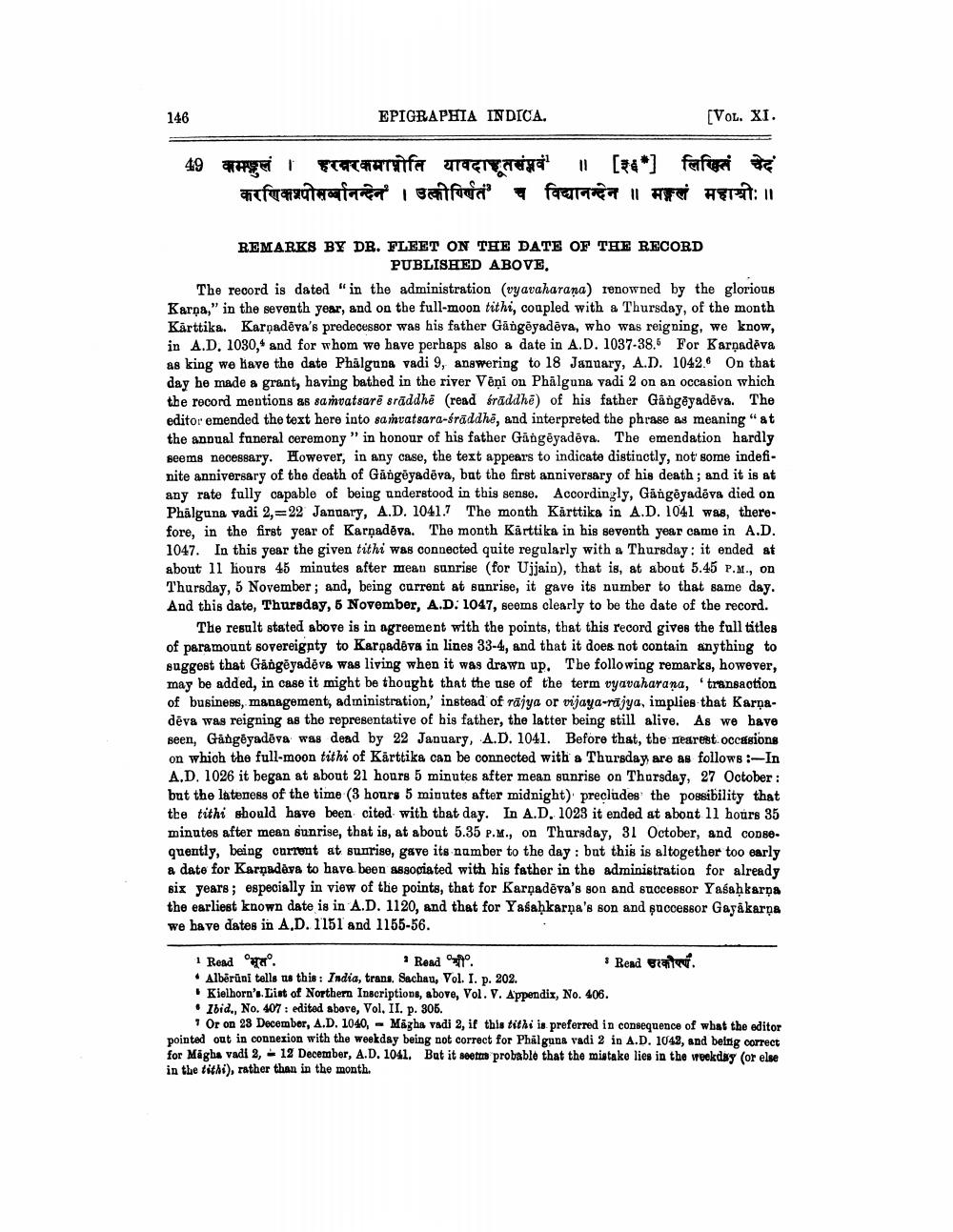________________
146
EPIGRAPHIA INDICA.
[VOL. XI.
॥ [₹६*] लिखितं चेद करणिकाश्पोसम्बनिन्देन । उत्कीति च विद्यानन्देन ॥ मङ्गलं महाश्री ॥
49 कम्मलं । हरवरकमाप्रीति यावदात
REMARKS BY DR. FLEET ON THE DATE OF THE RECORD PUBLISHED ABOVE.
The record is dated "in the administration (vyavaharana) renowned by the glorious Karna," in the seventh year, and on the full-moon tithi, coupled with a Thursday, of the month Kārttika. Karṇadeva's predecessor was his father Gangeyadeva, who was reigning, we know, in A.D. 1030, and for whom we have perhaps also a date in A.D. 1037-38.5 For Karpadeva as king we have the date Phalguna vadi 9, answering to 18 January, A.D. 1042. On that day he made a grant, having bathed in the river Vēņi on Phalguna vadi 2 on an occasion which the record mentions as samvatsare sraddhe (read śraddhe) of his father Gangeyadeva. The editor emended the text here into samvatsara-śraddhe, and interpreted the phrase as meaning "at the annual funeral ceremony" in honour of his father Gängeyadeva. The emendation hardly seems necessary. However, in any case, the text appears to indicate distinctly, not some indefinite anniversary of the death of Gangeyadeva, but the first anniversary of his death; and it is at any rate fully capable of being understood in this sense. Accordingly, Gangêyadēva died on Phalguna vadi 2, 22 January, A.D. 1041.7 The month Karttika in A.D. 1041 was, therefore, in the first year of Karnadeva. The month Karttika in his seventh year came in A.D. 1047. In this year the given tithi was connected quite regularly with a Thursday: it ended at about 11 hours 45 minutes after mean sunrise (for Ujjain), that is, at about 5.45 P.M., on Thursday, 5 November; and, being current at sunrise, it gave its number to that same day. And this date, Thursday, 5 November, A.D: 1047, seems clearly to be the date of the record.
The result stated above is in agreement with the points, that this record gives the full titles of paramount sovereignty to Karpadeva in lines 33-4, and that it does not contain anything to suggest that Gängeyadeva was living when it was drawn up. The following remarks, however, may be added, in case it might be thought that the use of the term vyavaharana, 'transaction of business, management, administration,' instead of rajya or vijaya-rajya, implies that Karpadēva was reigning as the representative of his father, the latter being still alive. As we have seen, Gängeyadeva was dead by 22 January, A.D. 1041. Before that, the nearest occasions on which the full-moon tithi of Karttika can be connected with a Thursday are as follows:-In A.D. 1026 it began at about 21 hours 5 minutes after mean sunrise on Thursday, 27 October: but the lateness of the time (3 hours 5 minutes after midnight) precludes the possibility that the tithi should have been cited with that day. In A.D. 1023 it ended at about 11 hours 35 minutes after mean sunrise, that is, at about 5.35 P.M., on Thursday, 31 October, and consequently, being current at sunrise, gave its number to the day: but this is altogether too early a date for Karpadava to have been associated with his father in the administration for already six years; especially in view of the points, that for Karpadeva's son and successor Yasaḥkarpa the earliest known date is in A.D. 1120, and that for Yasahkarna's son and successor Gayakarpa we have dates in A.D. 1151 and 1155-56.
1 Read
.
* Read.
Alberūni tells us this: India, trans. Sachau, Vol. I. p. 202.
Kielhorn's. List of Northern Inscriptions, above, Vol. V. Appendix, No. 406.
* Rend सरकोणं.
Ibid., No. 407: edited above, Vol. II. p. 305.
1 Or on 23 December, A.D. 1040, Magha vadi 2, if this tithi is preferred in consequence of what the editor pointed out in connexion with the weekday being not correct for Phalguna vadi 2 in A.D. 1043, and being correct for Magha vadi 2, 12 December, A.D. 1041. But it seems probable that the mistake lies in the weekday (or else in the tithi), rather than in the month.
-




